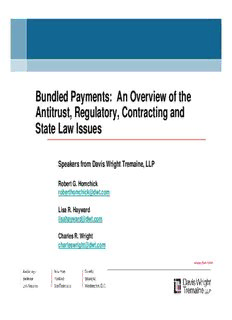
Bundled Payments: An Overview of the Antitrust, Regulatory PDF
Preview Bundled Payments: An Overview of the Antitrust, Regulatory
Bundled Payments: An Overview of the Antitrust, Regulatory, Contracting and State Law Issues Speakers from Davis Wright Tremaine, LLP Robert G. Homchick [email protected] Lisa R. Hayward [email protected] Charles R. Wright [email protected] Bundled Payment Models The term “bundled” describes a wide range of payment models. It often The term “bundled” describes a wide range of payment models. It often refers to a payment that encompasses more than one provider’s services refers to a payment that encompasses more than one provider’s services or an entire patient encounter, including global and packaged payments. or an entire patient encounter, including global and packaged payments. Hospital Hospital Outpatient Outpatient Physician Physician Global SNF SNF Payment Bundled NOTE: All covered services for a specific time period. Payment Particular Conditions Particular Conditions (e.g., diabetes) Packaged (e.g., diabetes) Payment Particular Episodes of Treatment Particular Episodes of Treatment (e.g., cardiac surgery, including (e.g., cardiac surgery, including 90 days of follow-up) 90 days of follow-up) 2 Bundled Payments: Contract Health Plan Health Plan Contract amendment - Contract amendment - look Contract amendment - Contract amendment - look outlines terms to hospital for payment outlines terms to hospital for payment Hospital or Group/IPA Hospital or Group/IPA New contract New contract New contract New contract Surgeon Optional package services Surgeon Optional package services Group/IPA or (rehab or other) Group/IPA or (rehab or other) Hospital Hospital New contract New contract Other MDs, PT Other MDs, PT 3 Bundled Payments: PHO Health Plan Health Plan Global Contract - Global Contract - outlines terms outlines terms Physician Physician Hospital Hospital PHO contracts Organization PHO contracts Organization with Participating with Participating Providers Providers Surgeon Surgeon Group/IPA or Group/IPA or Hospital Hospital Hospital Hospital Other MDs, PT Other MDs, PT 4 Bundled Payments (cid:131) Pay for Performance (e.g., quality, patient satisfaction, good citizenship) (cid:131) Pay for Savings (sometimes to as “gainsharing;” e.g., cost referred savings, standardization, efficiency) 5 Gainsharing Hospital pays percentage of resulting savings to physicians (cid:131) Product substitution - routine use of less costly agents, medications, etc. (cid:131) Product standardization - routine use of specified devices and supplies, e.g., stents, catheters, diagnostic devices, contrast agents, etc. (cid:131) Elimination of routine use of specified products or services (“use as needed”) 6 And the law… (cid:131) Physician Incentive Plan Law— “Gainsharing CMP” (cid:131) Stark Law (cid:131) Anti-Kickback Statute (cid:131) State Law Restrictions (cid:131) Corporate Practice of Medicine (cid:131) Fee Splitting (cid:131) Insurance/Risk Regulation (cid:131) State Self-Referral and Kickback Statutes (cid:131) Tax (cid:131) Antitrust 7 Gainsharing CMP: The Hospital “PIP law” (cid:131) Prohibits a hospital from knowingly paying, directly or indirectly, a physian to reduce or limit services provided to Medicare or Medicaid patients under the physician’s direct care (cid:131) Penalty of $2,000 for each affected Medicare or Medicaid patient (cid:131) Gainsharing CMP has been broadly interpreted by OIG—applies to payments to induce reduction of medically unnecessary care (cid:131) Payments to reduce costs have been equated with payments to reduce care (cid:131) HOWEVER: Gainsharing CMP applies only to Medicare and Medicaid FFS (cid:131) For managed care there is a separate PIP law that applies at the health plan level 8 Gainsharing - Regulatory Review (cid:131) 1999 OIG Special Advisory Bulletin on Gainsharing (cid:131) http://oig.hhs.gov/fraud/docs/alertsandbulletins/gainsh.ht (cid:131) Effectively halted the development of gainsharing programs in the short run (cid:131) In a series of subsequent Advisory Opinions the OIG identified the characteristics of acceptable Gainsharing programs (cid:131) Transparency (cid:131) Clinical Support (cid:131) Uniform application subject to cap (cid:131) Protections against inappropriate reductions in care (cid:131) Written disclosure to patients (cid:131) Reasonable compensation (cid:131) Per capita distributions 9 OIG Advisory Opinion No 08-16 The professional limited liability corporation (PLLC) model allowed the hospital to The professional limited liability corporation (PLLC) model allowed the hospital to pay select physicians for attaining hospital quality targets. pay select physicians for attaining hospital quality targets. Key Elements of OIG Advisory Opinion No. 08-16 (cid:131) The PLLC participation was open to a broad group of medical staff members (cid:131) Participating physicians were required to be members of the medical staff for at least 1 year (cid:131) Participating physicians equally capitalized the new entity, although costs were minimal (cid:131) The hospital paid the PLLC to meet predetermined quality targets (cid:131) Payments were capped at 50% of base-year P4P dollars (with inflation adjuster) (cid:131) Quality targets and payments renegotiated annually (cid:131) Monitoring in place to protect against inappropriate service reduction (cid:131) Physicians who change referral patterns to meet targets could be terminated (cid:131) The program maintained records of performance (cid:131) Patients informed of the program in writing (cid:131) The PLLC set physician participation criteria that did not induce referrals or incentivize more volume at the hospital 10
Description: